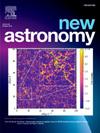Unraveling the broadband spectrum of B2 1308+326: A clue to its high energy emission mechanism
IF 2.1
4区 物理与天体物理
Q2 ASTRONOMY & ASTROPHYSICS
引用次数: 0
Abstract
The Flat Spectrum Radio Quasar (FSRQ) B2 1308+326 was in its highest -ray flaring state during 60260-60310 MJD. During this period, the source was detected in very high energy (VHE) by the large-sized telescope (LST-1). We conducted a detailed broadband spectral study of this source using the simultaneous data available in optical/UV, X-ray, and -ray bands. For the broadband spectral study, we select two gamma-ray high-flux states (59750-59800 MJD, 60260-60310 MJD) and one low-flux state (59250-59320 MJD). The broadband spectral energy distribution (SED) during these flux states are studied under leptonic emission scenario involving synchrotron, synchrotron self Compton (SSC) and external Compton (EC) processes. During the epochs, 59750-59800 MJD (high-flux state) and 59250-59320 MJD (low-flux state), the broadband SED is well fitted under the leptonic emission model while satisfying the equipartition between the particle and the magnetic field energy densities. However, the flaring state (60260-60310 MJD), during which the source showed VHE emission, demands deviation from equipartition by a factor of for the successful reproduction of the SED. This suggests the system may be under non-equilibrium condition or alternatively additional emission components may be active.
解开B2 1308+326的宽带频谱:其高能量发射机制的线索
平谱射电类星体B2 1308+326在60260-60310 MJD期间处于其最高的γ射线耀斑状态。在此期间,大型望远镜(LST-1)以甚高能量(VHE)探测到该源。我们利用光学/紫外、x射线和γ射线波段的同时数据对该源进行了详细的宽带光谱研究。为了进行宽带光谱研究,我们选择了两个伽马射线高通量态(59750-59800 MJD, 60260-60310 MJD)和一个低通量态(59250-59320 MJD)。研究了在同步加速器、同步加速器自康普顿(SSC)过程和外康普顿(EC)过程的轻子发射情况下这些磁通状态下的宽带频谱能量分布。在59750 ~ 59800 MJD(高通量态)和59250 ~ 59320 MJD(低通量态)时期,宽带SED在轻子发射模型下拟合良好,同时满足粒子与磁场能量密度的均分。然而,在燃烧状态(60260-60310 MJD),在此期间源显示出VHE发射,需要偏离均分约14倍才能成功复制SED。这表明系统可能处于非平衡状态,或者额外的发射成分可能是活跃的。
本文章由计算机程序翻译,如有差异,请以英文原文为准。
求助全文
约1分钟内获得全文
求助全文
来源期刊

New Astronomy
地学天文-天文与天体物理
CiteScore
4.00
自引率
10.00%
发文量
109
审稿时长
13.6 weeks
期刊介绍:
New Astronomy publishes articles in all fields of astronomy and astrophysics, with a particular focus on computational astronomy: mathematical and astronomy techniques and methodology, simulations, modelling and numerical results and computational techniques in instrumentation.
New Astronomy includes full length research articles and review articles. The journal covers solar, stellar, galactic and extragalactic astronomy and astrophysics. It reports on original research in all wavelength bands, ranging from radio to gamma-ray.
 求助内容:
求助内容: 应助结果提醒方式:
应助结果提醒方式:


